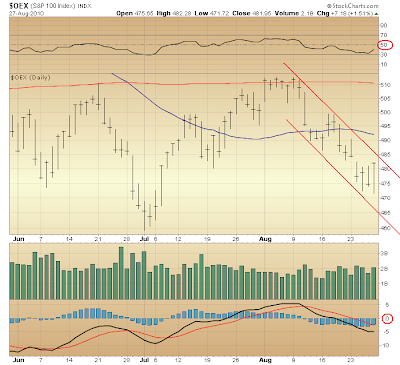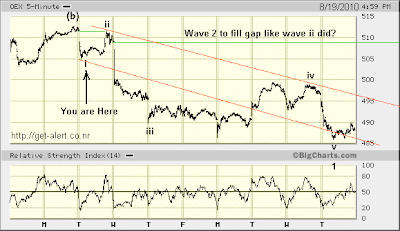I am not convinced today initiated the bounce I have been anticipating. There was curious weakness displayed...

We see a similar RSI divergence today as yesterday when the OEX peaked. Then, too, yet another divergence as today's peak RSI fell short of Wednesday's, this as the OEX rose a bit higher. This is making Tuesday's gap lower appear significant.
(On this note look how Monday's initial advance carried the OEX right up to its gap lower on Thursday prior, preceding the market's turning down hard yet again.)
So, there's reason to believe the decline since August 9th is not over. The fifth wave of five waves down likely could be still forming.

There is the five-wave channel from August 9th. The fifth wave is seen unfolding since August 18th.
Volume confirms this wave count, with its peak having come during formation of the third wave on August 11th, and its second best occurring a few days ago — Tuesday, 8/24/2010 — when the third wave of wave five down unfolded.
On the 5-minute chart above take notice of relative strength since Tuesday's sell-side extreme. You see how RSI appears to be improving — indeed, diverging as the OEX moved lower Wednesday and today. We saw this much the same earlier, as the 3rd wave down from August 9th was completing...

This was only followed by a further decline on Monday, August 16th, at the start of trading. Curiously enough, too, relative strength that Monday revealed increasing weakness, signaling more selling yet to come ... the likes of which we have seen, in fact, right up to today's turnaround. Thus, this past Tuesday's relative strength weakness — the greatest yet since August 9th peak — is seen suggesting more selling still to come ... the likes of which could complete the fifth wave of five waves down.
The market's decline since August 9th could challenge early-July bottom. Who knows, maybe RSI on the 5-minute chart will reach an even deeper sell-side extreme, signaling further weakness still ahead, and this in a rather revealing manner (at least to those paying attention).
So, following the projected completion of the fifth wave down upcoming, the spirit of Tuesday's July '09 Redux remains in play. In that piece I neglected to note something both important and plainly evident. The relative positions of both the 50-day and 200-day moving averages are precisely reversed, now versus July '09. This condition further supports an outlook supposing any bounce upcoming likely will be notably weaker. Today's more negatively poised moving averages are icing on the cake, whereas persistently weakening momentum over the course of the market's counter-trend rally off March '09 bottom are what the cake is made of. Seen in this context, these moving averages likely will prove formidable resistance at the very least.
This upcoming bounce has been anticipated for more days than it deserves, really. I say this notwithstanding the most recent American Association of Individual Investors survey finding just 21% of those polled bullish. This low measure is rivaled only by the 19% at March '09 bottom.
If anything, the market's upcoming bounce might prove more durable than meager. In other words, any move higher might take some time and still get relatively nowhere. Recent trends reveal a prolonged, narrow, directionless trade unfolding near tops, so this is a possible facet worth anticipating, as well.
You might recall that, back in July '08 bullish sentiment also tanked. This recovered some during the market's uneven bounce in August '08, while remaining decidedly below peak levels set prior to October 2007 (thus suggesting the market might rise further still). Yet nothing about reduced bullish consensus proved consequential, however, once it came time for the massive capital raise from September-October, 2008.
These sentiment readings have to be seen in the context of what has preceded. Following 2008's massive collapse and 2009's equally monstrous comeback, skepticism such as we are seeing here could prove counter-productive to weak-handed institutions (still much too leveraged) currently driving trading.
We know strong hands have been distributing equity ever more increasingly over the past thirteen years. So, forget about any substantive bid soon materializing on that front. Has this not already been thoroughly demonstrated over the course of the past year? That individuals want no part stands as but another bid source absent. This leaves institutions — some of which are well-capitalized — possibly more disposed to treating the situation in a manner like one would playing the game of Monopoly: seeking to hasten the bankruptcy of one's opponent. Could this explain the craziness developing between rivals HP and Dell?
Some argue the increase in M&A is a bullish sign. Were this so, though, would not banks be lending, venturing to capture a fair share of companies whose equity is judged undervalued? Indeed, was this not the order of things up until the securitization bubble popped?
Poor Bernanke and Geithner. They still believe the old order (and its infinite multiplier) can be restored. Their promise to flood the world with liquidity that is increasingly finding less "paper" and more "things" attractive is setting up for the mother of all imbalances whose name is hyperinflation. Yet that this is in fact a physical process and not a monetary one will become plainly evident by way of increasing scarcity: this as a result of countless businesses being driven into the ground, unable to bear costs soon-to-be astronomically rising.
Still, our idiot regulators will not let up, and this despite being called to account by way of high-profile dissent among their own, the likes of whom understand the end of the great paper chase over the past several decades is at hand. If these Monetarist Monkeys are not safely removed, we're screwed ... and sooner than most dare imagine.

* * * * *
© The Risk Averse Alert — Advocating a patient, disciplined approach to stock market investing. Overriding objective is limiting financial risk. Minimizing investment capital loss is a priority.
Analysis centers on the stock market's path of least resistance. Long-term, this drives a simple strategy for safely investing a 401(k) for maximum profit. Intermediate-term, investing with stock index tracking-ETFs (both their long and short varieties) is advanced. Short-term, stock index options occasionally offer extraordinary profit opportunities when the stock market is moving along its projected path.
Nothing is set in stone. Nor is the stock market's path of least resistance always known. More often than not, there are no stock index option positions recommended.
 There's an easy way to boost your investment discipline...
There's an easy way to boost your investment discipline...Get Real-Time Trade Notification!








